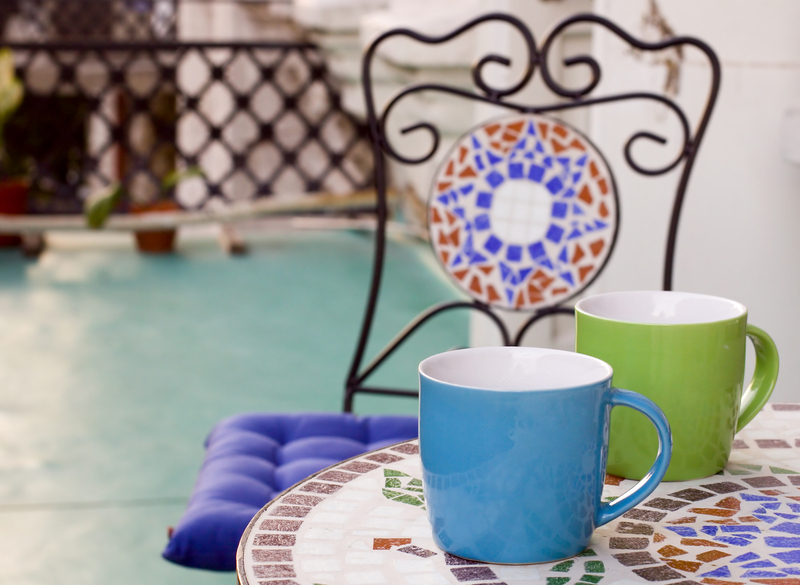Old Clothes and Linens Reimagined with Fun Upcycling Projects
Every home collects a mountain of old clothes and linens over the years. Instead of letting them languish in closets or sending them to a landfill, why not give them a second life? With a bit of creativity and sustainable spirit, you can turn tired textiles into something beautiful and practical. In this guide, we'll explore inspiring ways to reimagine old clothes and linens through fun upcycling projects. Discover tips, step-by-step ideas, and expert advice for transforming the forgotten fabrics in your home.

Why Upcycle Old Clothes and Linens?
- Reduce Waste: Each year, tons of textiles end up in landfills. Upcycling helps decrease environmental impact by extending their usefulness.
- Save Money: Create home decor, accessories, and gifts without buying new supplies.
- Unique Style: Handcrafted items give a personalized touch to your space or wardrobe.
- Boost Creativity: Upcycling is a fun way to nurture your artistic side and learn new skills.
- Community Impact: Donated or shared upcycled goods can support charitable causes.
Getting Started: Selecting Old Clothes and Linens for Upcycling
Before diving into DIY upcycled projects, it's important to sort through your stash. Here's how to choose the best candidates:
- Check Fabric Quality: Fabrics that are too thin or torn may not work for all projects, but they can still be great for quilting, stuffing, or cleaning rags.
- Look for Interesting Patterns & Textures: Vintage linens and colorful clothing add unique touches to any project.
- Don't Dismiss Stained Sections: Often, undamaged portions can be used, or stains can be covered with embellishments.
- Mix and Match: Combine different materials for patchwork projects and eye-catching designs.
Creative Upcycling Project Ideas for Old Clothes
1. T-Shirt Yarn Creations
Transform worn-out t-shirts into versatile yarn for crafts. Simply cut the shirts into strips and stretch them gently to make yarn, then use it for:
- Crocheting rugs, baskets, or trivets
- Macrame wall hangings and plant hangers
- Braided bracelets and necklaces
2. Patchwork Quilts and Throws
Old shirts, pajamas, and baby clothes can be cut into squares and stitched together. Making a patchwork quilt preserves memories and keeps you cozy. You can also create:
- Cushion covers
- Bed runners
- Tablecloths and picnic blankets
3. Denim Makeovers
Sturdy jeans and jackets offer endless upcycling possibilities.
- Jeans to Tote Bags: Cut along the inseam and sew the legs together to create spacious bags. Reinforce with the waistband as handles.
- Patchwork Skirts: Combine pieces from several pairs of jeans for a funky skirt.
- Applique Art: Cut shapes--like hearts or stars--for decorating plain t-shirts, backpacks, or jackets.
Tip: Keep pockets and zippers for handy storage compartments or unique decorative elements.
4. Fashion Accessories from Old Clothes
- Upcycled Headbands and Scrunchies: Use fabric from blouses or tees. These require simple sewing and add style to everyday wear.
- Fabric Necklaces and Brooches: Twist, braid, or layer strips of old garments and accent with buttons, lace, or beads.
- Handcrafted Tote Bags: Merge t-shirt bodies, button-ups, or dress fabrics for unique, reusable shoppers.
5. Repurposed Baby and Pet Items
- Soft Toys: Stuff small pillowcases or pieces of flannel with fabric scraps for homemade plushies.
- Pet Beds: Use heavy-duty jeans or corduroys filled with padding for cozy dog or cat beds.
- Baby Bibs and Bonnets: Sweet-smelling cotton and flannel shirts are ideal for practical, gentle baby accessories.
Upcycled Projects for Old Linens
1. Decorative Pillowcases and Covers
Vintage linens featuring laces, embroidery, or unique prints can become beautiful cushion covers. Simply sew the fabric around a pillow form and add buttons or ribbons as closures.
2. Table Runners and Placemats
Old tablecloths may be too worn for formal dining but have sections perfect for:
- Elegant table runners
- Colorful placemats
- Coasters and mug rugs
Enhance with decorative stitching, lace trims, or fabric paint for a fresh look.
3. Curtains and Window Decor
Lightweight linens make wonderful cafe curtains, cafe valances, or decorative tiebacks. Patch together tea towels or napkins for a bohemian vibe in your kitchen or craft room.
4. Storage Solutions and Organizers
Repurpose sturdy towels, tablecloths, or sheets into:
- Fabric baskets or bins for toys, crafts, or laundry
- Hanging organizers for closets or bathrooms
- Shoe bags or travel pouches
5. Zero-Waste Kitchen Helpers
- Reusable Napkins: Cut and hem squares from worn sheets or pillowcases.
- Unpaper Towels: Create a roll of washable towels for eco-friendly cleaning.
- Beeswax Wraps: Infuse cotton scraps with beeswax for a sustainable food wrap solution.
No-Sew Upcycling: Easy Projects for All Ages
Not everyone has access to a sewing machine, but you can still enjoy textile upcycling without stitching:
- T-Shirt Tote Bags: Simply cut the sleeves and neckline, turn the shirt inside out, and tie the bottom hem into knots.
- Fringe Scarves: Cut long strips from old t-shirts and stretch for soft, trendy scarves.
- Knotted Rugs: Braid or tie fabric strips together for boho-inspired rugs or mats.
- Fabric Gift Wraps: Use scarves, tea towels, or pillowcases to wrap gifts furoshiki-style.
How to Upcycle Old Clothes and Linens: Step-by-Step Tips
- Gather Supplies: Scissors, fabric glue, needles/thread (for sewing), and embellishments like buttons or lace.
- Wash and Prep: Launder materials and iron them for smooth cutting and sewing.
- Cut with Care: Outline patterns using chalk or fabric pens. Maximize usable fabric by cutting around stains or holes.
- Test Your Design: Arrange pieces before sewing or gluing to visualize the final result.
- Embellish: Add decorative touches such as embroidery, fabric paint, or applique to personalize your project.
- Finish Edges: Use zigzag stitches, serging, or fabric glue to prevent fraying.
Eco-Friendly Upcycling: Sustainability and Style
Upcycling isn't just a fun craft; it's an eco-friendly practice that benefits the planet:
- Reduces Greenhouse Gases: Less textile waste means fewer emissions from landfills and manufacturing plants.
- Limits Resource Consumption: Upcycling uses what you already have, which conserves water and raw materials needed to produce new fabrics.
- Promotes Circular Economy: By reimagining clothing and linens, you encourage a culture where resources are reused and repurposed instead of discarded.
By choosing textile upcycling, you make a meaningful difference for the environment without sacrificing style or comfort.
Tips for Success: Making the Most of Your Upcycled Projects
- Start Small: Begin with easy projects like tote bags or napkins before working on larger quilts or garments.
- Mix Materials: Don't be afraid to combine different types, such as denim with lace or flannel with cotton.
- Repair and Reinforce: Upcycled items can be fragile if not properly constructed. Double-stitch seams and use interfacing where needed.
- Share or Sell: Handmade upcycled creations make unique gifts or can be sold at craft fairs and online markets.
- Get Creative: Experiment with dyes, fabric painting, embroidery, and unexpected decorative elements to elevate your work.
Inspiring Upcyclers: Stories from the Community
Jane's Story: Turning Memories Into Comfort
Jane from Vermont inherited a box of her grandmother's tablecloths and pillowcases. Rather than letting them deteriorate, she pieced them into a king-size quilt that keeps her family warm while preserving history.
Upcycling with Kids: Maddie's Fashion Show
Ten-year-old Maddie hosted a backyard fashion show featuring dresses, skirts, and accessories that she and her friends designed from family hand-me-downs. Old neckties became belts, and a tired bedsheet transformed into a fairy princess gown.
From Waste to Wealth: Crafting a Business
After years in retail, Marcus started a side business making dog toys, grocery totes, and coasters from obsolete hotel linens. His Etsy shop now supports his family and provides high-quality, sustainable goods to customers nationwide.

Frequently Asked Questions about Upcycling Old Clothes and Linens
Can any type of fabric be upcycled?
Most natural and synthetic fabrics can be repurposed, but sturdier materials (like denim or cotton) offer longer-lasting results. Extremely delicate fabrics may be best for decorative ideas or combined with others for added strength.
What if I don't know how to sew?
Many upcycling projects require basic hand-sewing or no sewing at all. Try fabric glue, safety pins, or knotting methods for accessible crafts.
How do I care for upcycled items?
Wash according to the fabric's requirements. Gentle cycles and air drying help preserve the structure of quilted or patchwork creations.
Can upcycled items be donated?
Absolutely! Many charities and animal shelters appreciate handmade items, such as blankets or pet beds.
Conclusion: Give Old Clothes and Linens New Life with Upcycling
Our closets and linen cupboards are treasure troves of materials just waiting to be transformed. By embracing fun upcycling projects for old clothes and linens, you'll enjoy a fulfilling, meaningful hobby that reduces waste, saves money, and celebrates imagination. Whether you make a patchwork quilt, a denim tote, or a kitchen organizer out of vintage tea towels, every project is an opportunity to craft something unique and eco-friendly.
So, gather your old fabrics, let your creativity flow, and start reimagining the endless possibilities for upcycled textiles today!